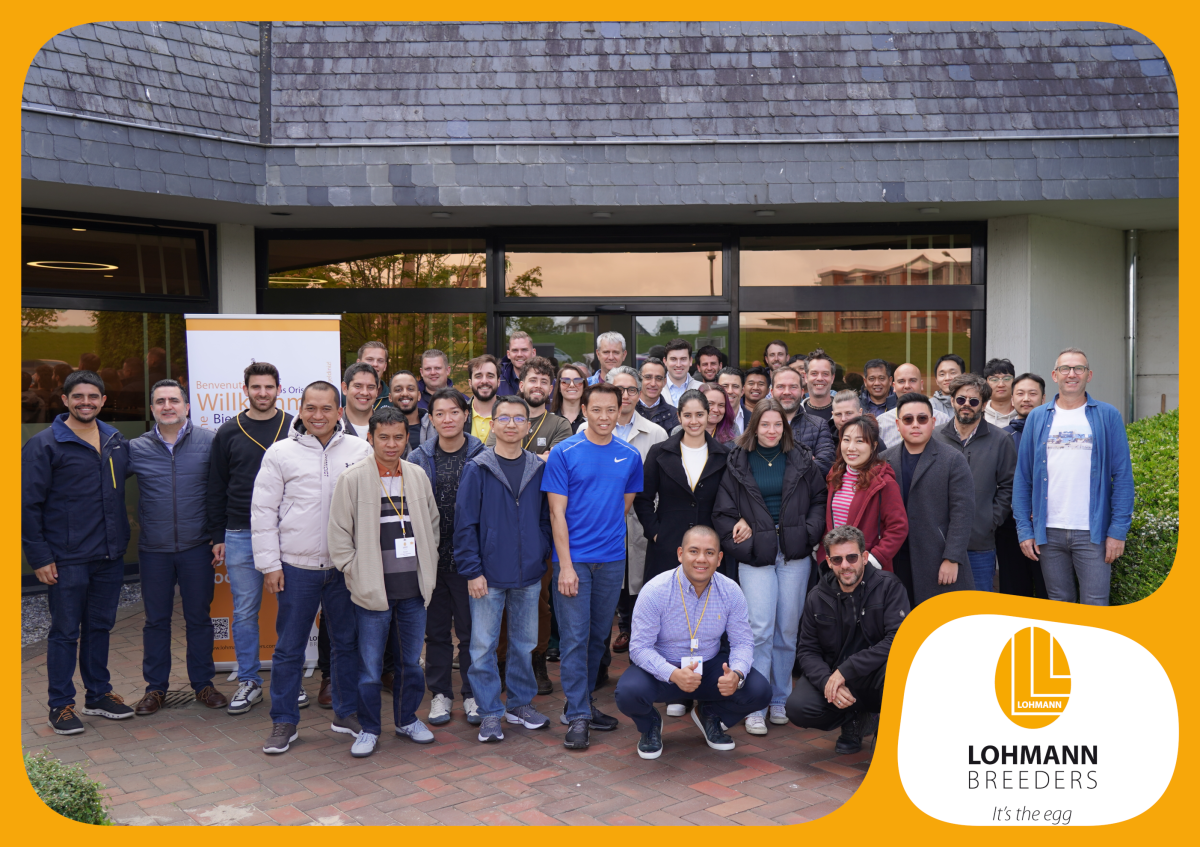
Contact address: Susanne.rothstein@gmx.de
After her agricultural science studies with focus on animal nutrition at University of Bonn, Dr. Susanne Rothstein successfully finished her PhD thesis at University of Göttingen on the subject of insects as alternative protein source in fattening pig and broiler nutrition. Currently she is working at Biochem Zusatzstoffe Handels- und Produktionsgesellschaft mbH as R&D Application Manager in the field of organically bound trace minerals for all animal species.
Summary
Alternative protein sources are gaining importance to substitute imported soybean meal (SBM) in poultry nutrition. Latest international research activities in broiler nutrition is focusing on the partial replacement by insect meal. Nutritionally, it would make sense because poultry originally would choose insects as protein sources as well. The highest possibility for industrialization of insects as feed has been observed for black soldier fly larvae (Hermetia illucens).
Two growth studies were conducted to evaluate the potential of replacing 50 % or 100 % SBM by partly defatted Hermetia illucens larvae meal (HIM) in broiler diets with different levels of crystalline amino acid (AA) supplementation. Studies were evaluated based on diet acceptance, performance, and feed efficiency.
At least comparable or even improved weight gain, feed intake and feed conversion ratio were consistently recorded for the 50 % to 100 % SBM replacement by HIM with adjusted amino acid levels in Ross 308 broiler. Only at a basic level of amino acid supplementation, equal to the control, 50 % substitution of SBM by HIM depressed the zootechnical parameters significantly. The quality of the dietary AA balance was more important than the substitution level.
In consequence, HIM is a promising alternative protein source in chicken diets when the dietary AA balance is well adapted to the ideal AA ratio recommendations.
Keywords:
Broiler, Poultry nutrition, Soybean meal, Hermetia illucens, Insect meal, Alternative protein source, Black Soldier Fly.
INTRODUCTION
he predicted increase of global human population up to 9.7 billon citizens in 2050 require a 70 to 100 % expansion in food production to cover the additional demand of two billion people extra and getting one billion humans away from starving [FAO, 2013]. Furthermore, the increasing animal protein consumption in emerging countries call for an extension of protein feed material production [Smith et al., 2013]. In contrast the available arable land is getting short by mankind consumption and pollution, as well as new markets like renewable energies going in competition for the limited areas. A continuous improvement of production efficiency is a common practice in livestock farming.
Nutritionists are mainly tackling this target by formulating demand-oriented diets and thereby reducing emissions. Nevertheless, livestock farming is being faced with increasing negative publicity over the last years while the primarily used protein feed material soybean is mainly produced in Latin America and imported to Europe. Thereby investigations shall find environmentally friendly alternative protein sources delivering soybeans comparable nutritional characteristics, by respecting the economy without negative effects on animal and human health [Stiles, 2016]. In the recent years researching about replacing soybean as feed material by using insects became of high scientific interest. Main systematic advantages of the insects are the options to grow on organic waste and food processing by-products which have no other useful value today [Newton, 2005]. In addition, the use if insects for poultry feeding would reduce the requirement for arable land [Rumpold und Schlüter, 2013] with positive effects on CO2 footprint.
As the daily meal of wild birds and free-range poultry naturally containing insects [Miao et al., 2005], the implementation of insects in the livestock farming may be associated with higher animal welfare and improved consumer acceptance [Verbeke et al., 2015]. Numerous fundamental research studies have been figured out that the larvae of the black soldier fly (Hermetia illucens) is of high interest for poultry feeding. Hermetia illucens (HI) is not only having a high crude protein content (35 to 44 % in dry matter) with an adequate amino acid (AA) profile, but also a high fat content (18 to 39 % in dry matter). These characteristics make HI attractive for poultry feed. Within the last few years first studies already evaluated partly substitution of soybean meal (SBM) by HI meal in different countries.
Those studies finished with promising performance results in broiler. In some markets the establishment of HI in livestock diets is ongoing already. The European Food Safety Authority initiated a risk profiling of using insects in food and feed. In this they described their doubts about the potential risk of pathogen transfer, which would depend on the substrate and the production systems (EFSA, 2015). But a first step to use insects has been done, because in the European Union the usage of HI in aquaculture is allowed since 2017 (Commission Regulation (EU) 2017/893).
General questions on the possibilities to substitute SBM by partly defatted Hermetia illucens meal (HIM) have also been evaluated within the multidisciplinary project: ’Sustainability Transitions in food production: alternative protein sources in socio-technical perspective’, funded by the Lower Saxonian Vorab through the state’s Ministry for Science and Culture. As part of the project, the current experiments evaluated the potential of substituting 50% or 100% of SBM by HIM in diets for meat type chickens during the entire fattening period (starter and grower).
MATERIAL AND METHODS
Two consecutive growth studies were conducted at the Department of Animal Sciences, Division Animal Nutrition Physiology of Goettingen University.
Stocks and husbandry
Each of the experiment [Table 1] was divided into a starter period (1-21d) and a grower period (22-34d). One day old male Ross 308 broiler chickens from a commercial hatchery (WIMEX Agrarprodukte, Hatchery Rosefeld Germany) were randomly allotted to 48 floor pens of 6 birds each (Study 1) or 7 birds each (Study 2). Average body weights (BW) per pen were similar at the start of each experiment. Birds were bedded on wood shavings with free access to feed and water. They were kept under controlled environmental conditions following the breeding companies’ recommendations [Aviagen, 2014]. Each experiment included a control diet (n=12) and 2 experimental diets (n=9).
SBM = Soybean meal; HIM = partly defatted Hermetia illucens larvae meal; AA level of amino acids
IAAR = Ideal Amino Acid Ratio [Wecke and Liebert, 2013]; Met = Methionine; Cys = Cysteine
Basic: methionine and lysine adjusted to the control diet; 80% Met+Cys: methionine and cysteine level reduced to 80 % of recommended requirement
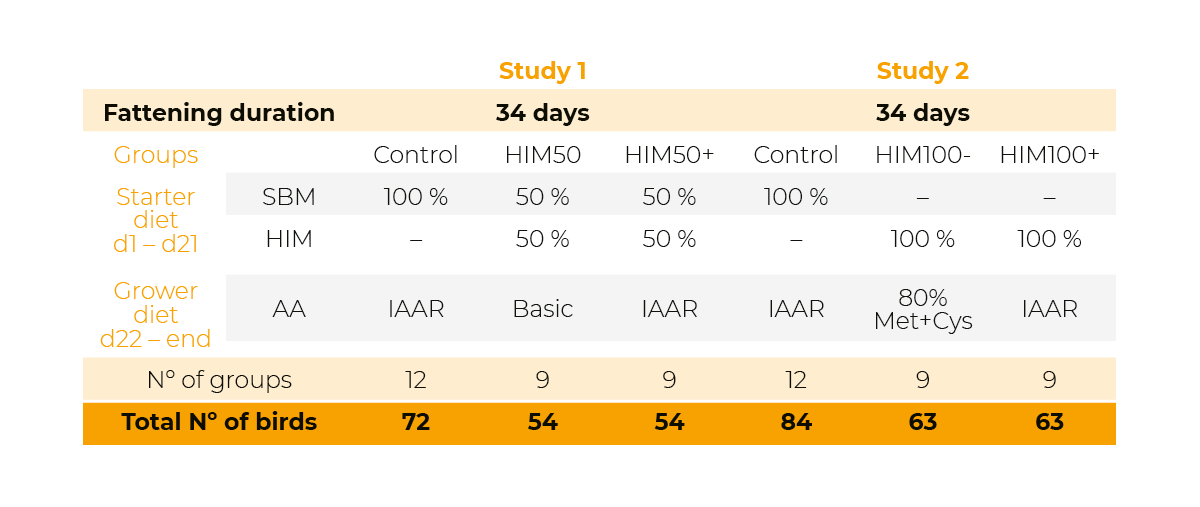
Feed material
Wheat and corn were selected as standard feed materials because they are most relevant in broiler nutrition. SBM is the commonly used protein feed material in European broiler diets and was the basis in the control diets. In these studies, SBM with 48 % crude protein was used [Table 2]. HIM was obtained from a commercial producer (Hermetia Futtermittel GbR, Baruth/Mark, Germany). The black soldier fly larvae grown on a substrate blend from rye flour and wheat bran for 20 days. After getting separated of the substrate larvae were dried for 14 hours at 65˚C to 70˚C, then partly defatted with a screw press, and ground into a meal.
SBM=Soybean meal; HIM = partly defatted Hermetia illucens larvae meal
DM = Dry matter; XP = Crude Protein; XL = Crude Fat; XF = Crude Fiber; XA = Crude ash; Lys = Lysine; Met = Methionine; Cys = Cysteine; Thr = Threonine; Arg = Arginine; Val = Valine
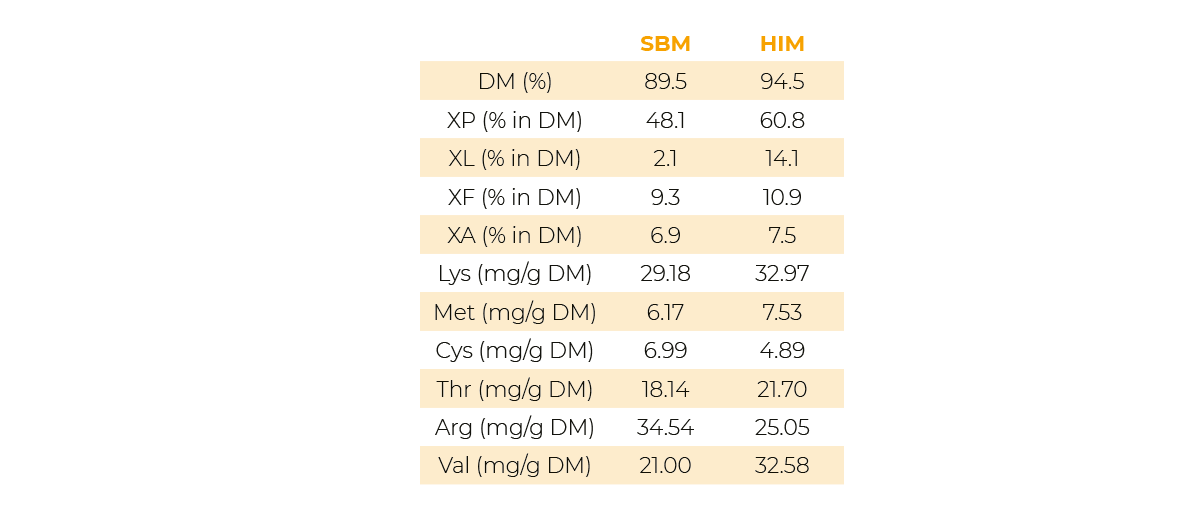
Diets and Feeding
The pelleted diets [Figure 1] for all experiments were manufactured at the facilities of the Division Animal Nutrition Physiology at the University of Goettingen with an institute owned feed production line. This line is specifically dimensioned being accurate even at small batch sizes. The two studies mainly differ in the experimental diets. Varying replacement levels of SBM with HIM, and differing supplementation level of crystalline AA. The control diets were based on wheat, corn and SBM as the main ingredients.

Diet concepts in both studies focused on the protein levels and AA ratios. Therefore, the ratio wheat to corn was constant at 2 : 1 in all diets to avoid any shift in the AA ratio by these feed materials [Table 3].
OM = original feed material; DM = Dry matter; AME N = Nitrogen corrected apparent metabolizable energy, calculated according WPSA [1984]; NfE = Nitrogen free extract; CP = Crude Protein; EE = ether extract Fat; CF = Crude Fiber; CA = Crude ash; HIM50, HIM50+, HIM100- and HIM100+ description like in Table 5.
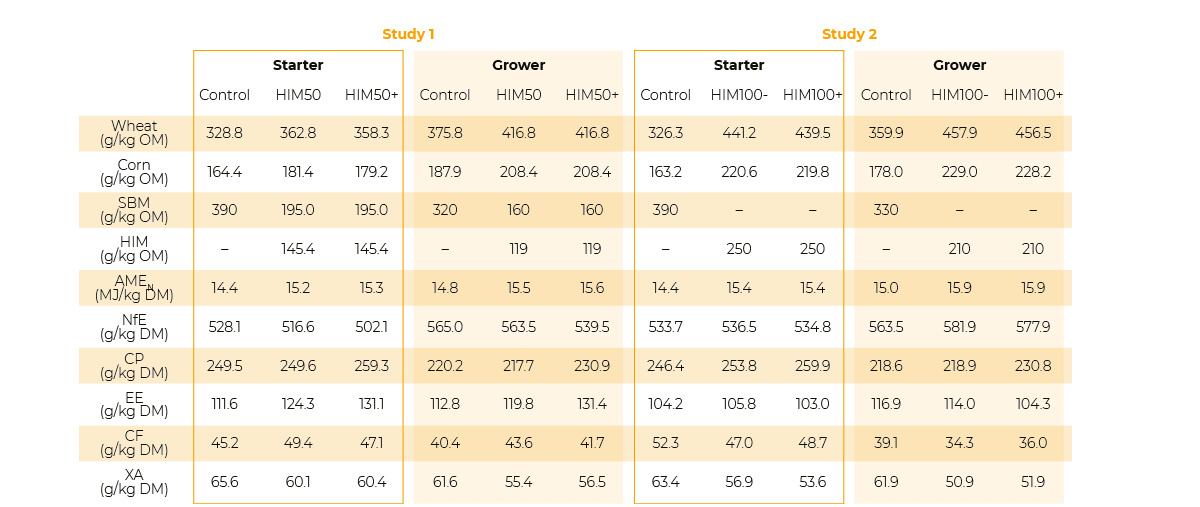
The experimental diets in Study 1 examined the 50 % replacement of SBM by HIM, both at a basic and an advanced level of AA fortification. For the basic level (diet HIM 50), Lys and Met supplementation was equal to the control diet. The main target was about getting a first impression on exchangeability of SBM by HIM without any AA adjustment.
The advanced level of AA fortification (diet HIM 50+) aimed to yield an improved dietary AA balance according to the currently assumed ideal AA ratio (IAAR) (Wecke and Liebert, 2013). Therefore, in addition to Lys and Met, further AAs (Thr, Arg, Val) were supplemented [Table 4]. Study 2 investigated the effects of complete SBM substitution by HIM in starter and grower diets. Therefore, the experimental diet HIM100+ used the insect meal as the only main protein source. Individual diet supplementation with AAs is summarized in Table 4.
As compared with Study 1, all diets were AA supplemented at the extended level to meet the IAAR. But in the second experimental diet (HIM100-), the concentration of the calculated first limiting AA was reduced to 80% of its requirement recommendation. In this case Methionine plus Cysteine was reduced in order to allow further evaluations of individual AA efficiency.
*as calculated; OM = original feed material; SBM = Soybean meal; HIM = partly defatted Hermetia illucens larvae meal. HIM50, HIM50+, HIM100- and HIM100+ description like in Table 5.
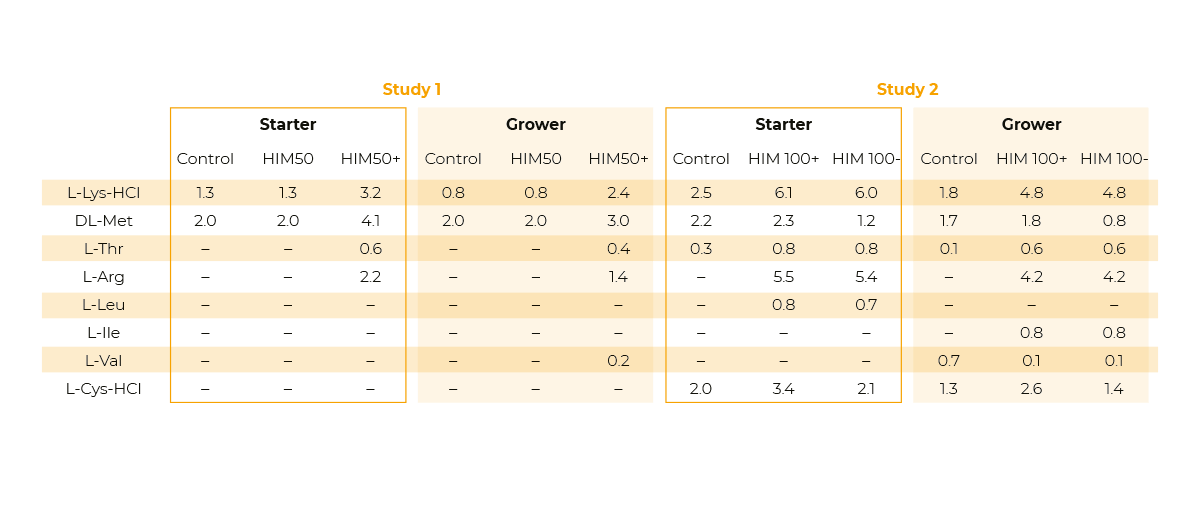
RESULTS AND DISCUSSION
As already mentioned, the zootechnical performance and efficiency indices are of main interest to evaluate the potential of HIM in broiler production. Feed costs represent approximately 70 % of the total production costs and the farmers react extremely sensitive on the weight gain performance and the correlated feed efficiency. The used protein source, and especially its protein quality is of high importance for the feed efficiency and thus of interest for feed producers.
The reached average BW of control groups in both studies match the Ross 308 performance objective of 2179 g (Aviagen, 2014). At the same time, realized feed conversion ratio (FCR) within the control groups were even better than the genetic target of 1.52 [Table 5]. That indicates that the overall growing conditions, and the control feed were selected well. This can be confirmed, as medical treatments were not required in both studies.
BW = Body weight; BWG = Body weight gain; FI = Feed intake; FCR = Feed conversion ratio;
PCR = Protein conversion ratio; ECR = Energy conversion ratio; HM50: substitution of 50 SBM with HIM without amino acid adjustment;
HIM50+: substitution of 50 % SBM with HIM with amino acid adjustment to ideal AA ratio IAAR;
HIM100-: substitution of 100 % SBM with HIM with reduced methionine level; HIM100+: substitutionof 10 % SBM with HIM and adjustment of amino acids to the ideal amino acid ration IAAR.
a-c/x-zdifferent superscript letters indicate significant differences within the respective study (p<0.05)
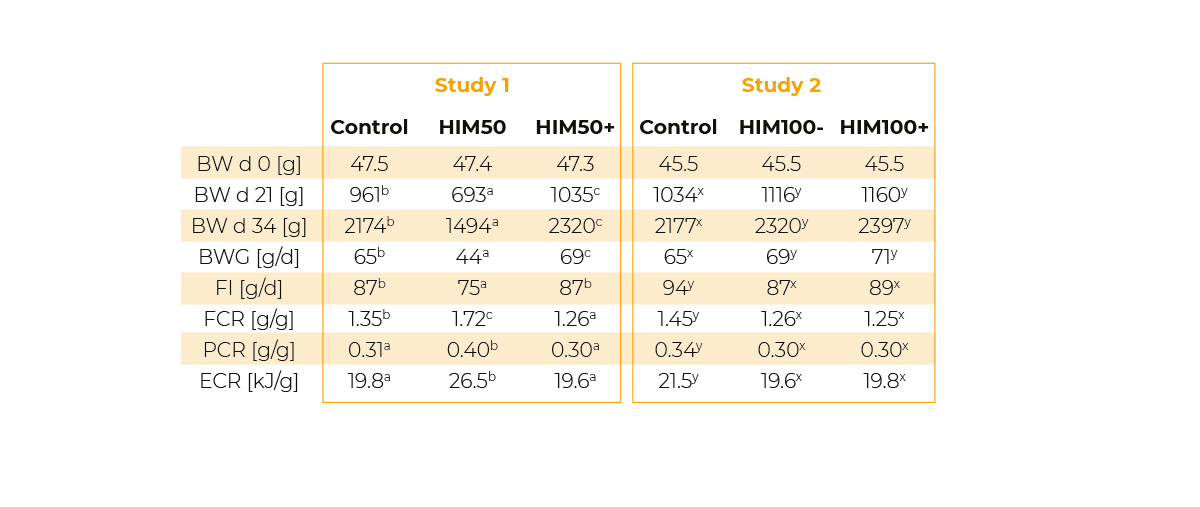
Within the first study the 50 % replacement of SBM by HIM at only a basic AA supplementation (HIM50) resulted in significant lower BW gain. Furthermore, the feed efficiency was worse being visible in higher FCR, as well as protein, and energy conversion ratios [Table 5]. This depressed performance is the outcome of a lower feed intake. Some research groups only observed an acceptable feed intake at HIM inclusion rates of maximum 10 % [Dabbou et al., 2018]. In the first study of this project the HIM inclusion rate was about 15 % in the starter and 12 % in the grower phase [Table 3].
In contrary to these results other studies have not observed any negative effect on the feed intake in broilers [UUSCHONA,2015], or even positive effects in quails [Cullere et al., 2016] with inclusion rates of up to 15 %. These contradicting results are discussed in literature being a consequence of the HIM sources.
The used growth substrate, time of harvest, and the processing are having an influence on the body composition, and in consequence the nutritional ingredients of the insects.
In the present study the product quality cannot be the point, because all broilers in the HIM experimental groups were fed with the same product. For example, HIM50+ group have not shown any negative effect on the feed intake. In addition, this group finished on significantly higher average final BW of 2320 g and thereby 146 g heavier than the control group [Table 5]. Comparable observations have been reported in other studies (Oluokun, 2000; Cockroft, 2018).
A much deeper discussion about the results from the first study and even more can be found in the publication from Velten et al. [2018a, b]. In the second study of this project HIM inclusion rates of 25 % in the starter, and 21% in the grower diet were required to get a total replacement of SBM realized [Table 3], without negative effects on the final body weight, as well as the feed efficiency [Table 5].
That underlines, that the depressed feed intake in the first experimental diet was not caused by acceptance problems of the insect-based feed. But these first results indicate that especially the AA ratio has influenced the feed intake, and consequently the performance criteria. The control group, and group HIM50+ received the feed in accordance with the IAAR (Wecke and Liebert, 2013), while the HIM50 only received a basic supplementation of Lysine and Methionine.
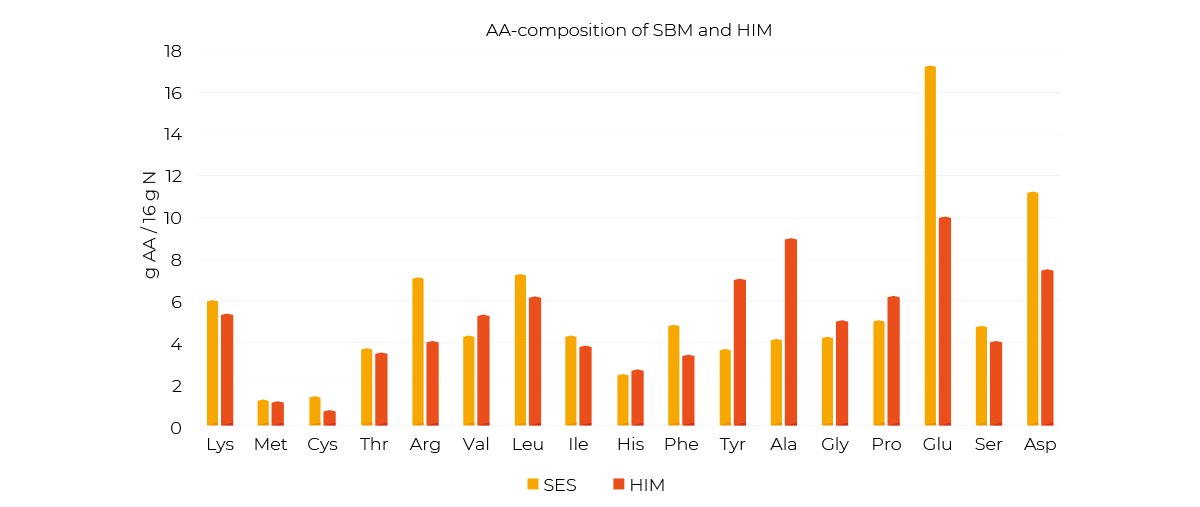
A quite good lineup of the AA profile of the used SBM and HIM gives Figure 2.
The used HIM contained similar amounts of Lysine, Methionine, and Threonine, but had clearly lower levels in Cysteine, Arginine, Leucine, and Isoleucine compared to SBM. Effectively after comparison with the IAAR of broilers, the HIM50 group received feed with insufficiency amounts in some AA. The unbalanced ratio of AA resulted in a worse protein conversion ratio [Table 4]. In the HIM50+ group these deficits have been eliminated by additional supplementation of crystalline Lysine, Methionine, Threonine, and Arginine.
In comparison to the SBM control diet, the HIM50+ group resulted in a comparable protein conversion ratio [Table 5]. The complete replacement of SBM by HIM increased the demand of crystalline AA supplementation in the second study to reach the IAAR from (Wecke and Liebert, 2013). Compared to the control group, the HIM100+ group finished with significantly improved feed, protein, and energy conversion ratios [Table 5]. These results are promising that insects could be an efficient alternative protein source. Unfortunately, no further studies have been evaluated protein, and / or energy efficiency on HIM in broiler feed.
The reduction of sulfurous AA (Methionine and Cysteine) on 80 % of the recommended values at a Methionine to Cysteine ratio of 50:50 in the HIM100- group did not influenced the overall performance compared to the experimental group HIM100+. The supply of the first limiting AA was reduced to measure protein deposition under circumstances of its validated limiting position. More details can find in the study from Neumann et al. [2018] or Rothstein, [2019].
From a practical point of view this adjustment reduced the supplemented level of crystalline AA, which resulted in lower feed costs, but further investigations are needed to exploit the complete potential of AA supplementations in order to achieve an optimal AA balance in diets with a high substitution level of SBM by HIM.
Accompanying measurements on the apparent precaecal AA digestibility of the feed mixtures, which should reflect an absorption rate for the individual AA up to the end of the small intestine without considering endogenously secreted AA (therefore “apparent”), indicate a higher absorption rate of the AA when using the insect meal compared to the control with SBM [Rothstein, 2019].
However, these measured values have to be considered cautiously due to low repetition rates and further investigations are advisable. In both studies all HIM containing feed mixtures supplied slightly higher energy density, compared to the control diets [Table 3]. However, it was not the aim of the experimental design to compensate for this obvious effect by adding plant oil to the final mixture. But for sure, this difference had a not quantifiable influence on the growth, and especially on the feed efficiency.
Therefore, future studies should consider more intensively the HIM fat content by using isocaloric diets. It is also recommended for animal nutritionists to monitor the fatty acid pattern. In the context of growing insects locally on food by-products and being able to grow broilers without reduction in energy, and protein efficiency could make this concept attractive for future broiler production.
Additionally, in further sensoric tests of the meat quality of the fattened broilers, HIM-fed animals did not differ from the SBM group. First results indicated that breast filet from HIM-fed Broilers taste very well and there was no difference in shelf life of packaged HIM meat with the control (Altmann et al., 2018).
Conclusions
The examined studies have shown that partially defatted meal from Hermetia illucens larvae is a promising alternative protein source in feed mixtures for broilers. Under consideration of an adequate amino acid supplementation adapted to the respective species-specific ideal amino acid ratio, a 100 % substitution of soybean meal is nutritional possible.
Therefore, it is important to establish production capacities to generate relevant volumes in consistent and homogenic quality on economic pricing levels. Furthermore, the European Union needs to adapt the regulations to allow the feeding of Hermetia illucens meal in poultry livestock.
ACKNOWLEDGEMENT
The study was supported by the Lower Saxony Ministry of Science and Culture (ZN 3041).
References
Altmann, B. A., Neumann, C., Velten, S., Liebert, F. and Mörlein, D. (2018): Meat Quality Derived from High Inclusion of a Micro-Alga or Insect Meal as an Alternative Protein Source in Poultry Diets: A Pilot Study. Foods, 7, 34. https://doi.org/10.3390/foods7030034 Aviagen (2014). Ross 308 Broiler. Standard und Sollwerte. Handbuch.Cockcroft, B.L. (2018): An evaluation of Defatted Black Soldier Fly (Hermetia illucens) Larvae as a Protein Source for Broiler Chicken Diets. Master Thesis, Stellenbosch Universität. http://scholar.sun.ac.za/handle/10019.1/103626 , 20. July 2018
Cullere, M., Tasoniero, G., Giaccone, V., Miotti-Scapin, R., Claeys, E., De Smet, S. and Dalle Zotte, A. (2016): Black Soldier Fly as a Dietary Protein Source for Broiler Quails: Apparent Digestibility, Excreta Microbial Load, Feed Choice, Performance, Carcass and Meat Traits. Animal, 10, 1923-1930. https://doi.org/10.1017/S1751731116001270
Dabbou, S., Gai, F., Biasato, I., Capicchino, M.T, Biasibetti, E., Dezzutto, D., Meneguz, M., Plachá, I., Gasco, L. and Schiavone, A. (2018): Black Soldier Fly Defatted Meal as a Dietary Protein Source for Broiler Chickens: Effects on Growth Performance, Blood Traits, Gut Morphology and Histological Features. Journal of Animal Science and Biotechnology, 9, 49-58. https://doi.org/10.1186/s40104-018-0266-9
EFSA (2015): Risk Profile Related to Production and Consumption of Insects as Food and Feed. EFSA Journal, 13. https://doi.org/10.2903/j.efsa.2015.4257 FAO (2013): Edible Insects-Future Prospects for Food and Feed Security. FAO Forestry Paper No. 171, (Hrsg.): FAO, Rome.
http://www.fao.org/docrep/018/i3253e/i3253e.pdf , 15. Mai 2018
Miao, Z.H., Glatz, P.C. and Ru, Y.J. (2005): Free-range Poultry Production – A Review. Asian-Australasian Journal of Animal Sciences, 18, 113-132. https://doi.org/10.5713/ajas.2005.113
Neumann, C., Velten, S. and Liebert, F. (2018): The Graded Inclusion of Algae (Spirulina platen-sis) or Insect (Hermetia illucens) Meal as a Soybean Meal Substitute in Meat Type Chicken Diets Impacts Growth, Nutrient Deposition and Dietary Protein Quality Depending on the Extent of Amino Acid Supplementation. Open Journal of Animal Sciences, 8, 163-183. https://doi.org/10.4236/ojas.2018.82012
Newton, L., Sheppard, D.C., Watson, D.W., Burtle, G.J., Dove, C.R., Tomberlin, J. and Thelen, E.E. (2005b): The Black Soldier Fly, Hermetia illucens, as a Manure Management/ Resource Recovery Tool. https://pdfs.semanticscholar.org/5aa5/81bf66145ee15551c0a86df6436b9183fd05.pdf 20. Juni 2018
Oluokun, J.A. (2000): Upgrading the Nutritive Value of Full-Fat Soybeans Meal for Broiler Production with either Fishmeal or Black Soldier Fly Larvae Meal (Hermetia illucens). Nigerian Journal of Animal Science, 3. Abstract: https://doi.org/10.4314/tjas.v3i2.49768 , 10. August 2018.
Rothstein, S. (2019): Ernährungsphysiologische Bewertung von teilentfettetem Larvenmehl der schwarzen Soldatenfliege (Hermetia illucens) für den Einsatz in ressourcenschonenden Ernährungskonzepten der Schweine- und Hähnchenmast. Dissertation, Agrarwissenschaftliche Fakultät der GAU, Göttingen http://hdl.handle.net/21.11130/00-1735-0000-0005-128F-6
Rumpold, B.A. and Schlüter, O.K. (2013): Potential and Challenges of Insects as an Innovative Source for Food and Feed Production. Innovative Food Science and Emerging Technologies, 17, 1-11. https://doi.org/10.1016/j.ifset.2012.11.005
Smith, J., Sones, K., Grace, D., Macmillian, S., Tarawali, S. and Herrero, M. (2013): Beyond Milk, Meat, and Eggs: Role of Livestock in Food and Nutrition Security. Animal Frontiers, 3, 6-13. https://dx.doi.org/10.2527/af.2013-0002
Stiles, W. (2016): The case for alternative protein sources for animal feed.
https://businesswales.gov.wales/farmingconnect/sites/farming/files/technical_article_-_protein_alternatives_final_1.pdf , 03rd May 2018
Velten, S., Neumann, C., Bleyer, M., Gruber-Dujardin, E. Hanuszewska, M., Przybylska-Gornowicz, B. and Liebert, F. (2018a): Effects of 50 percent substitution of soybean meal by alternative proteins from Hermetia illucens or Spirulina platensis in meat-type chicken diets with graded amino acid supply. Open Journal of Animal Sciences, 8, 119-136. https://doi.org/10.4236/ojas.2018.82009 Velten, S., Neumann, C., Schäfer, J. and Liebert, F. (2018b): Effects of the partial replacement of soybean meal by insect or algae meal in chicken diets with graded amino acid supply on parameters of gut microbiology and dietary protein quality. Open Journal of Animal Sciences, 8, 259-279.
https://doi.org/10.4236/ojas.2018.83020
Verbeke, W., Spranghers, T., De Clercq, P., De Smet, S., Sas, B. and Eckhout, M. (2015): Insects in Animal Feed: Acceptance and its Determinants among Farmers, Agriculture Sector Stakeholders and Citizens. Animal Feed Science and Technology, 204, 72-87. https://doi.org/10.1016/j.anifeedsci.2015.04.001 Wecke, C. and Liebert, F. (2013): Improving the Reliability of Optimal In-Feed Amino Acid Ratios Based on Individual Amino Acid Efficiency Data from N Balance Studies in Growing Chicken. Animals, 3, 558-573. https://doi.org/10.3390/ani3030558
WPSA (1984): The Prediction of Apparent Metabolizable Energy Values for Poultry in Compound Feeds. World´s Poultry Science Journal, 40, 181-182.



